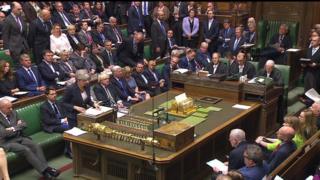
The deal struck this week between the Conservatives and the DUP gives the government a majority in the House of Commons on certain votes, enabling it to win the vote on the Queen’s Speech.
With the DUP, it has a majority of six across all 650 MPs – but with the seven Sinn Fein MPs not taking their seats, in practice it is a working majority of 13.
That’s still an uncomfortably small number. It would only take a rebellion of seven people to defeat the government if all opposition MPs were to vote together.
We have already seen how the government has had to be more responsive to its backbenchers, conceding to demands that women from Northern Ireland should be able to receive free abortions in England.
But it is not just rebellions that the government needs to worry about. The majority could be eroded over time if the Conservatives or DUP were to lose seats at by-elections.
Image copyright
Getty Images
Jim Callaghan (left) and Sir John Major both lost their majorities
Seven losses might sound a lot but if we look back at previous parliaments it is by no means unprecedented. Just ask Jim Callaghan or Sir John Major. Their governments lost their majorities because of illness, defection and death.
The Conservative government suffered a net loss of eight seats at by-elections between 1992 and 1997; and seven seats between 1987 and 1992.
The 1974-79 Labour government also lost seven seats, eliminating its wafer-thin majority and ultimately leading to defeat in a vote of no confidence in the House of Commons.
These turbulent times were dramatised on the West End stage in the play This House, which showed how, in 1978 and 1979, MPs were taken to votes in ambulances. Government whips also had special keys to unlock toilet doors to ensure drunken MPs weren’t napping on the toilet.
Image copyright
NT
Between 1966 and 1970 Labour’s net loss was 15 seats. That was a particularly tough Parliament for the Labour Party because 20 sitting MPs died, as those elected two decades earlier in the 1945 landslide fell to ill health and old age.
In the 1960s, many Labour MPs had endured harder lives than their Conservative counterparts because they often came from manual professions such as mining or factory work.
The table below shows how many seats governing parties have gained or lost at by-elections over the course of each parliament since World War Two.
In four of those 19 parliaments, the government lost at least seven seats.
It means that Theresa May doesn’t just have to fear backbench rebellions; she also has to fear illness, defection and death.
}

